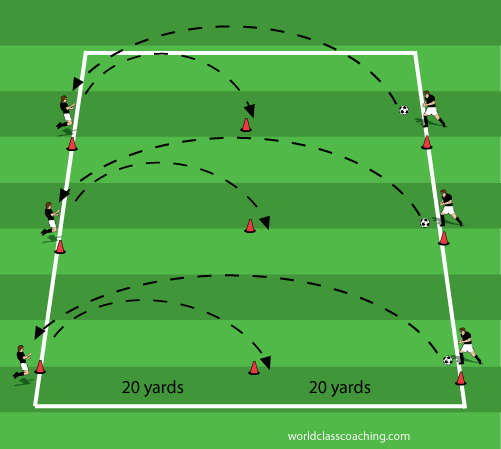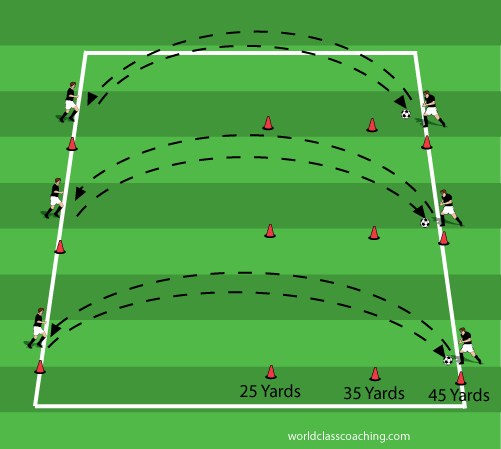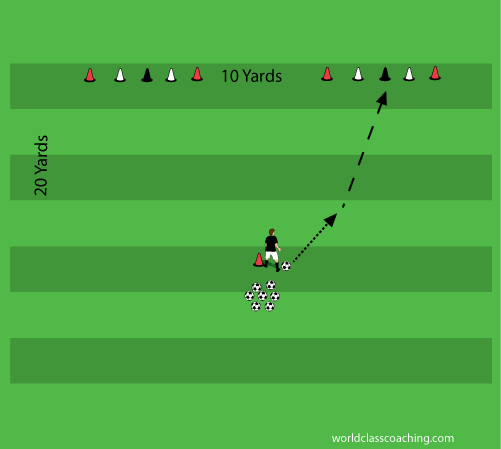I've always liked the way that Anson Dorrance attempts to quantify everything that his teams do in practice. Keeping score creates motivation and encourages a competitive attitude better than anything else.
This also creates a benchmark that you can test against later in the season to gauge how effective your training sessions have been in each area. So not only are these test motivation for the players but also great tools for the coach to evaluate his or her methods.
The following exercises were presented by Anson Dorrance when he was a clinician at the WORLD CLASS COACHING International Coaching Seminar.
Anson Dorrance – North Carolina Women’s Soccer Technique Olympics
Anson Dorrance – UNC Preseason Camp
Anson is feels that it’s very important to objectively quantify as much in the game as possible. The reason is that they want to see if they’re doing the right things in practice. So they are quantifying technique. This was the beginning of the ‘Competitive Caldron’ which had a huge impact on developing the mentality of the teams at UNC and the 1996 US National Team.
UNC PRESEASON CAMP
The objective is to make sure the players are working on technique during the summer in addition to fitness.
Serving and Heading
The object of this test is to challenge the girls to serve the ball accurately over 30 yards and head the ball effectively.
Each girl picks a player that they have to pass the test with. The server must pass the ball to receiving player. Receiving player must head the ball past the middle cone. Ten balls are served and the header must get six of them past the cone.
The roles then reverse and the other player serves balls for her partner to head.

Serving and Receiving
The objective of this test is to test a player’s ability to serve and receive over distance. The exercise is accomplished in pairs at three different distances; 25 yards, 35 yards, and 45 yards. Players serve and receive for one minute at each distance. The serving player serves a pass to the receiving player. Coach awards the players a point if the pass reaches the receiving player and the receiving player is able to control the ball out of the air. Receiving player must control the ball out of the air and serve the ball back at game speed in order to receive a point. If the receiving player has a poor first touch or the serve does not clear the line, the players are not awarded a point. Coach awards points at each level and totals points upon completion of the exercise.
Progression – Alternate which foot is serving
Start out at 25 yards
Move to 35 yards
Mover to 45 yards
Figure 8 Dribbling
The player starts behind one cone and proceeds to dribble the ball in a figure 8 around two cones. The distance between cones is ten yards. Each player completes three one-minute cycles. Each cycle is completed with a different restriction: inside of the foot only, outside of the foot only, and both with any part of the foot. A coach counts the number of times the player completes the circut to the nearest quarter.
A quarter is deducted for each fault (touch with the wrong part of the foot). Example: 7 and 3/4 circuits completed with two faults, they players score for the exercise is 7 and 1/4.
Brazilian Technical Passing
The player begins by running forward and passes the ball toward the target. If the player hits the center cone they receive three points. If it goes between the cones on either side of the center cone they receive two points. If the ball goes through the the widest cones without touching them the player receives one point. No points are scored if the player misses the target or hits the outside cones. The player gets one minute to score as many points as possible.
The ball should be passed with the right foot at the target on the right and left foot on the other side.
These are just a few of the skills that they measure during the preseason at UNC. You can see all of them along with sessions from Curt Onalfo, Lauren Gregg and Mauricio Marques in the KC Seminar 2008 Journal.





